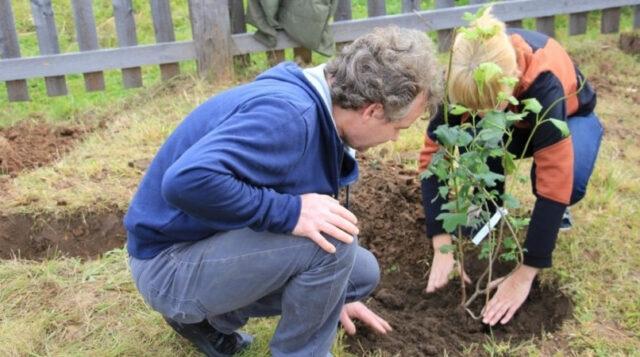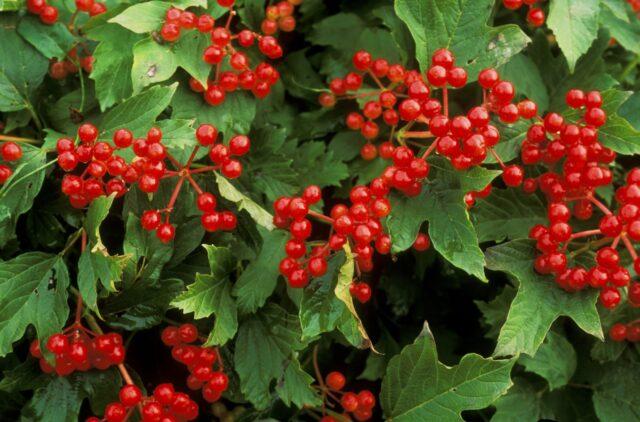Content
- 1 When is the best time to plant viburnum?
- 2 Planting rules and growing conditions for viburnum
- 3 How to properly plant a viburnum bush in autumn and spring
- 4 How to plant and grow viburnum from seeds
- 5 How to care for viburnum
- 6 Features of planting and caring for viburnum in different regions
- 7 Recommendations and common mistakes
- 8 Conclusion
Viburnum is a fruit-bearing shrub that has been grown in Rus' for a long time. The plant was considered a symbol of youth and beauty; legends, poems and songs were written about it. But recently, this useful crop has been undeservedly forgotten, so its distribution area has decreased significantly. But now the plant is gradually regaining popularity, and many gardeners prefer to grow it on their site. Planting and caring for viburnum is not difficult if you know the basic requirements of this crop. Therefore, you should study the rules for planting, placing this shrub on the site and further care.

Planting must be carried out before the beginning of the growing season of the bush or at its end.
When is the best time to plant viburnum?
Viburnum can be planted in spring and autumn. But the second option is preferable, as it allows you to get a well-rooted seedling for the new season. Planting in the spring should be carried out before the beginning of the growing season, when the soil thaws to a depth of 25 cm, and the air temperature confidently remains at +10 degrees.
You cannot delay the timing during this period, otherwise the plant will take a long time to adapt. When planted in spring, viburnum seedlings begin to grow green mass to the detriment of root development. Therefore, it is necessary to carry out the procedure during this period of the year only as a last resort.
When to plant viburnum in the fall
The optimal time for planting viburnum in the fall is considered to be the end of September - the beginning of October, but it is necessary to additionally focus on the climatic conditions of each region. The seedling must be planted at least three weeks before the onset of persistent frost. This will give the viburnum the opportunity to fully adapt and prepare for winter.
Planting rules and growing conditions for viburnum
This culture belongs to the category of unpretentious. Therefore, planting and caring for viburnum in open ground will not cause difficulties even for a novice gardener. For the full development and fruiting of this shrub, you only need to choose the right place, taking into account the requirements of the culture.

Some varieties can be propagated by seeds and cuttings
Where is it better to plant viburnum on the site?
For shrubs, you should choose well-lit areas, protected from cold gusts of wind.But it is also permissible to grow red viburnum plants in slightly shaded places in the garden, however, flowering and fruiting in this case will occur 10 days later.
Is it possible to plant viburnum in the yard, near the house?
It has long been customary to plant red viburnum near the house, since this shrub was considered a natural amulet that could protect its inhabitants from harm. This plant was also credited with the ability to endow a person with vitality, bring happiness and prosperity.
The current superstitions that viburnum cannot be planted near the house are not supported by any beliefs or reliable facts. Therefore they are completely unfounded. The only disadvantage of such planting may be that this crop needs good watering, and this can damage the foundation of the house. Therefore, it is best to plant viburnum in the yard or garden.

Red viburnum is a woody garden plant of the Adoxaceae family.
Soil requirements
This shrub grows well in sandy and loamy soil with a neutral acidity level. It should be taken into account that, despite the moisture-loving nature of viburnum, the groundwater level must be at least 1 m. Otherwise, after several years of successful growth, the shrub may die. This will happen as a result of erosion of the soil near the roots.
The soil in the area intended for this crop must have good moisture and air permeability.
How to properly plant a viburnum bush in autumn and spring
With proper planting and care, red viburnum will be able to produce crops regularly.Therefore, it is necessary to plant a seedling taking into account the basic requirements of the crop.
The area for this must be prepared at least two weeks before the procedure. It must be dug up to the depth of a shovel and perennial weeds must be carefully removed. The planting hole for viburnum should also be prepared in advance. It should be 50 by 50 cm in size. Place a drainage layer on the bottom, and fill the rest of the space with a nutrient mixture of turf, humus, peat and sand in a ratio of 2:1:1:1. Additionally, add 40 g of superphosphate and 25 g of potassium sulphide to the planting hole and thoroughly mix the fertilizers with the soil to prevent burns to the roots. For planting, it is better to choose three-year-old seedlings with a well-developed root system.
Algorithm of actions:
- Make a small mound of soil in the center of the hole.
- Place viburnum on it, straighten the roots.
- Sprinkle them with soil, shaking the seedling periodically to fill all the voids.
- Compact the soil surface.
- Water the seedling generously.
How to plant and grow viburnum from seeds
If you wish, you can grow viburnum from a seed. But for this it is necessary to first stratify the planting material.
In this case, immediately after collection in the fall, the seeds must be placed in a nylon stocking and placed in damp sawdust or moss. They need to be kept at a temperature of +18-23 degrees for two months. In the future, transfer the viburnum seeds to a cool place with a temperature of +4 degrees, so the best option may be a refrigerator or basement. They need to be kept in this mode for 1 month.
After stratification is completed, it is necessary to plant the seeds in a nutrient substrate without burying the subcotyledon in the soil. At the end of February - beginning of March, the sprouts are completely freed from the top cover and seedlings appear. They reach a height of 5-8 cm and have two pairs of leaves. Viburnum seedlings must be kept at home throughout the year, and seedlings can be planted in open ground only next spring, when they are strong enough.
How to care for viburnum
Growing viburnum in the country will not cause much trouble for the gardener. With proper care, this shrub will be able to bear fruit in the second year after planting. Therefore, it is necessary to study all the features of agricultural technology in advance.

Viburnum can grow in one place for up to 40 years
What and when to fertilize
This plant needs regular watering, so it is better to use dry fertilizers. They simply need to be scattered in the root circle and then embedded in the ground. After each feeding, the viburnum needs to be watered abundantly.
In the spring, it is necessary to apply fertilizers with a high nitrogen content to the shrub. To do this, you can use ammonium nitrate or urea at the rate of 30-50 g per plant, depending on its age. Also during this period you can use rotted organic matter.
The second time it is necessary to fertilize during the formation of inflorescences. During this period, wood ash should be used at the rate of 0.5 kg per bush. Also at this time you can use nitroammophoska 40 g per plant.
The third time you need to apply fertilizer is during the period of fruit formation. At this time, superphosphate (40 g) and potassium sulfide (25 g) should be used.This fertilizing will accelerate the ripening of fruits and increase the winter hardiness of the shrub.
Diseases and pests
Red viburnum can be affected by various diseases. The most common of them are powdery mildew, frost blight, ascochyta blight, gray rot and fruit rot. To prevent damage, it is necessary to carry out preventive treatment of the bush with fungicides, such as Bordeaux mixture, “Hom” and “Skor”.
Pests can also cause damage to red viburnum: leaf beetle, black aphid, leaf roller, gall midge, moth. To combat them, it is necessary to use insecticides when the first warning signs appear. For processing use Inta-Vir, Actellik and Confidor Extra.

Treatment of bushes should be carried out in dry, windless weather.
Preparing for winter
To successfully winter the shrub, you need to carry out water-recharging watering in the first half of October. You should also place a 10 cm thick layer of humus in the root circle. The crown of young seedlings should be wrapped in two or three layers of agrofibre.
Viburnum bushes need to be protected from rodents. To do this, the shoots at the base should be wrapped in roofing felt and secured.
Features of planting and caring for viburnum in different regions
Depending on the growing region, the timing of planting viburnum may vary. Therefore, this should be taken into account, otherwise the seedling may die.
Planting and caring for viburnum in the Moscow region
In the central regions of the country, autumn planting of viburnum is considered preferable. It can be carried out from the end of September and over the next two weeks.But you should understand that you cannot delay the deadlines, since in the Moscow region there may be early frosts and the plant must have time to take root before they occur.

Viburnum can be used as a hedge
Planting and caring for viburnum in Siberia
When growing shrubs in regions with risky farming, the optimal time for planting viburnum is spring. The procedure should be carried out before the beginning of the growing season, when the air temperature does not fall below +4 degrees, regardless of the time of day.
If planting is carried out earlier than this period, there is still a possibility of the seedling dying in the event of return spring frosts.
Recommendations and common mistakes
Proper planting and care of the red viburnum bush will allow you to count on it bearing fruit every year. This will make it possible to have not only a beautiful plant in the garden or yard, but also a constant source of healthy berries. However, there are features that must be taken into account when growing viburnum in the garden.
Basic recommendations:
- The shrub should be placed away from other fruit trees, as it attracts many pests and birds.
- The plant loves abundant watering during dry periods, but does not tolerate prolonged stagnation of moisture in the soil. Therefore, you need to moisten the soil in doses.
- For planting, you should choose seedlings whose height is at least 20 cm, but not higher than 1.2 m.
- Every five to seven years, old bushes should undergo anti-aging pruning.
- When planting, nitrogen fertilizers and fresh manure cannot be applied, as they interfere with rooting.
Conclusion
Planting and caring for viburnum is not difficult, since this crop belongs to the category of unpretentious ones. At the same time, the plant will be able to look organically in the garden and disguise any unsightly areas. By growing viburnum, you can be sure that it will become a talisman for your home, which will protect it from all kinds of adversity.










